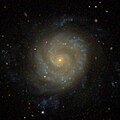NGC 3596
Appearance
| NGC 3596 | |
|---|---|
 NGC 3596 imaged by the Hubble Space Telescope | |
| Observation data (J2000 epoch) | |
| Constellation | Leo |
| Right ascension | 11h 15m 06.2152s[1] |
| Declination | +14° 47′ 13.404″[1] |
| Redshift | 0.003979±0.000002[1] |
| Heliocentric radial velocity | 1,193±1 km/s[1] |
| Distance | 57.24 ± 6.82 Mly (17.550 ± 2.092 Mpc)[1] |
| Apparent magnitude (V) | 12.0[1] |
| Characteristics | |
| Type | SAB(rs)c[1] |
| Size | ~74,900 ly (22.97 kpc) (estimated)[1] |
| Apparent size (V) | 4.0′ × 3.8′[1] |
| Other designations | |
| UGC 6277, MCG +03-29-013, PGC 34298, CGCG 096-013[1] | |
NGC 3596 is an intermediate spiral galaxy in the constellation Leo. It was discovered by German-British astronomer William Herschel on 8 April 1784.[2] It is located below the star Theta Leonis (Chertan).[3] It is a member of the Leo II Groups, a series of galaxies and galaxy clusters strung out from the right edge of the Virgo Supercluster.[4]
Image Gallery
[edit]-
SDSS image of NGC 3596
-
Legacy Surveys image of NGC 3596
See also
[edit]References
[edit]- ^ a b c d e f g h i j "Results for object NGC 3596". NASA/IPAC Extragalactic Database. NASA and Caltech. Retrieved 2006-10-24.
- ^ Seligman, Courtney. "New General Catalogue Objects: NGC 6261". Celestial Atlas. Retrieved 30 April 2025.
- ^ "WikiSky DSS2 image of Chertan and NGC 3596". Wikisky. Retrieved 2010-05-16.
- ^ "The Leo III Groups". Atlas of the Universe. Archived from the original on July 22, 2012. Retrieved 2010-11-27.
External links
[edit] Media related to NGC 3596 at Wikimedia Commons
Media related to NGC 3596 at Wikimedia Commons- Galaxy NGC 3596
- NGC 3596 on WikiSky: DSS2, SDSS, GALEX, IRAS, Hydrogen α, X-Ray, Astrophoto, Sky Map, Articles and images


